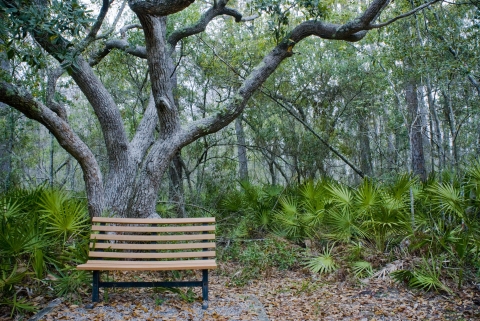Visit Us
National wildlife refuges offer us all a chance to unplug from the stresses of daily life and reconnect with our natural surroundings.
The Grand Bay Coastal Resources Center serves as the headquarters for the Grand Bay National Estuarine Research Reserve and the Grand Bay National Wildlife Refuge. The Interpretative Area is open to the public 9:00 a.m. – 3:00 p.m. Monday through Friday. The center is closed on all State Holidays.
Visitors to Grand Bay National Wildlife Refuge (NWR) are encouraged to begin their tour at the Grand Bay Coastal Resources Center’s interpretive center. Here visitors will learn about the diverse habitats located at Grand Bay NWR and the flora and fauna that make this place home.
Once oriented, there are two nature trails where excellent opportunities for wildlife observation abound.
Summer in southeastern Mississippi can be very hot and humid with heat indices over 100 degrees Fahrenheit a common occurrence. Visitors are advised to bring water and sun protection (hat, sunscreen, etc.). Biting insects at Grand Bay National Wildlife Refuge can be very intense and numerous, insect repellent is advised.
Activities
The 36,597-acre refuge is bisected by the Pearl River, with portions in St. Tammany and Washington Parishes in Louisiana and Pearl River County in Mississippi.
Grand Bay National Wildlife Refuge is located in coastal Mississippi and Alabama. The refuge was established in 1992 to help protect one of the largest remaining expanses of Gulf Coast wet pine savanna habitat.
The 10,188 acre refuge partially overlays the Grand Bay National Estuarine Research Reserve. Together, they protect nearly 18,000 acres of relatively undisturbed wildlife habitat.
In addition to the wet pine savanna, other refuge habitats include maritime forest, tidal and non-tidal wetlands, salt marshes, salt pans, bays and bayous.
These numerous and varying habitats provide a unique opportunity to view the diverse numbers of species that make their home here.
The refuge provides numerous opportunities to explore and enjoy the rich wildlife and habitats found here. From hiking and birding, to hunting and fishing, there are many different ways to appreciate all that the refuge has to offer.
Trails
There are four trails on the refuge that offer excellent opportunities for wildlife viewing and birdwatching. The refuge has very little elevation-gain, offering easy walks without losing any of the nature-experience opportunities. For more information on the trails, stop by the visitor center.
Other Facilities in the Complex
Grand Bay National Wildlife Refuge is managed as part of the Gulf Coast Complex. A National Wildlife Refuge Complex is an administrative grouping of two or more refuges, wildlife management areas or other refuge conservation areas that are primarily managed from a central office location. Refuges are grouped into a complex structure because they occur in a similar ecological region, such as a watershed or specific habitat type, and have a related purpose and management needs. Typically, a project leader or complex manager oversees the general management of all refuges within the complex and refuge managers are responsible for operations at specific refuges. Supporting staff, composed of administrative, law enforcement, refuge manager, biological, fire, visitor services, and maintenance professionals, are centrally located and support all refuges within the complex.
Other refuges in the Gulf Coast Complex include: Mississippi Sandhill Crane National Wildlife Refuge and Bon Secour National Wildlife Refuge. The Refuge Complex headquarters is located at 7200 Crane Lane, Gautier, MS 39553.
Rules and Policies
Grand Bay National Wildlife Refuge regulations are designed to protect and preserve natural, scenic, and wildlife values and to enhance public safety and enjoyment of the refuge. The following is a general summary of refuge regulations:
Refuge Hours
Visitors are welcome to recreate in the refuge during daylight hours only.
Hiking
Hiking is permitted on designated refuge trails.
Closures
Areas within refuge boundaries may be closed to public entry due to sensitive species or restoration activities. Be aware of signs indicating closed areas.
Dogs
Dogs are allowed in certain areas of the refuge, such as the designated hiking trails and Visitor Center grounds. They must be kept on a leash at all times. Please be mindful of other visitors and pick up after your pet.
Horseback Riding
Horseback riding is not permitted at the refuge.
Bicycles
Visitors may ride bicycles along the Bayou Heron Road -- Bayou Heron Road is a public road, so bicyclist must observe all state regulations and be aware that motorized vehicles will be sharing the roadway. Bicycles are not allowed on refuge trails.
Camping
There is no camping at the refuge, however, camping can be found at nearby Shepard State Park in Gautier, MS (call 228-497-2244 or visit http://shepardstatepark.com/ for more information)
Fires
Fires are prohibited.
Collecting of Natural or Cultural Objects
Removal of plants, animals or archaeological material is prohibited.
In case of an emergency, call 911.
Locations
The Grand Bay Coastal Resources Center serves as the headquarters for the Grand Bay National Estuarine Research Reserve and the Grand Bay National Wildlife Refuge. The Interpretative Area is open to the public 9:00 a.m. – 3:00 p.m. Monday through Friday. The center is closed on all State Holidays.
Visitors to Grand Bay National Wildlife Refuge (NWR) are encouraged to begin their tour at the Grand Bay Coastal Resources Center’s interpretive center. Here visitors will learn about the diverse habitats located at Grand Bay NWR and the flora and fauna that make this place home
Take Exit 75 off of I-10 and turn south on Franklin Creek Road. Go south to Hwy 90 and cross onto Pecan Road. Cross over the railroad tracks and continue down Bayou Heron Road for approximately 1 mile. The Visitor Center is on the right.
Coastal Resource Center Address:
6005 Bayou Heron Road Moss Point, MS 39562 228-475-0765 mississippisandhillcrane@fws.gov




